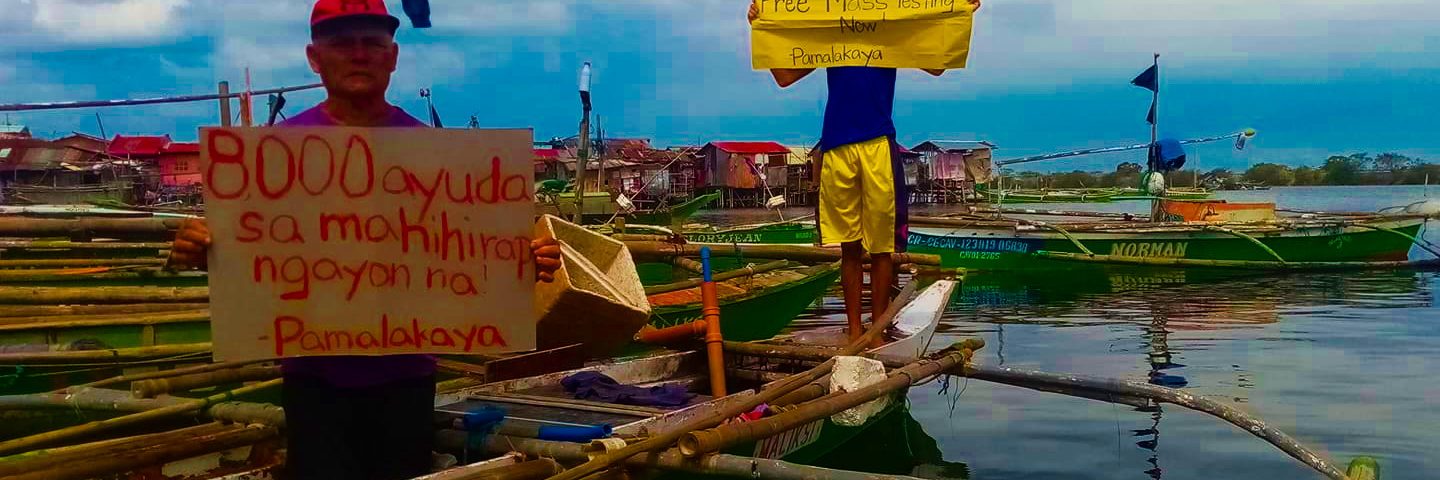Situation of Small Fisherfolk under COVID-19 Pandemic Lockdown
by Fernando “Ka Pando” Hicap, National Chairperson
Pambansang Lakas ng Kilusang Mamamalakaya ng Pilipinas
(Pamalakaya, National Federation of Small Fisherfolk Organizations in the Philippines)
September 2020
Small Fisherfolk as Vulnerable Sector
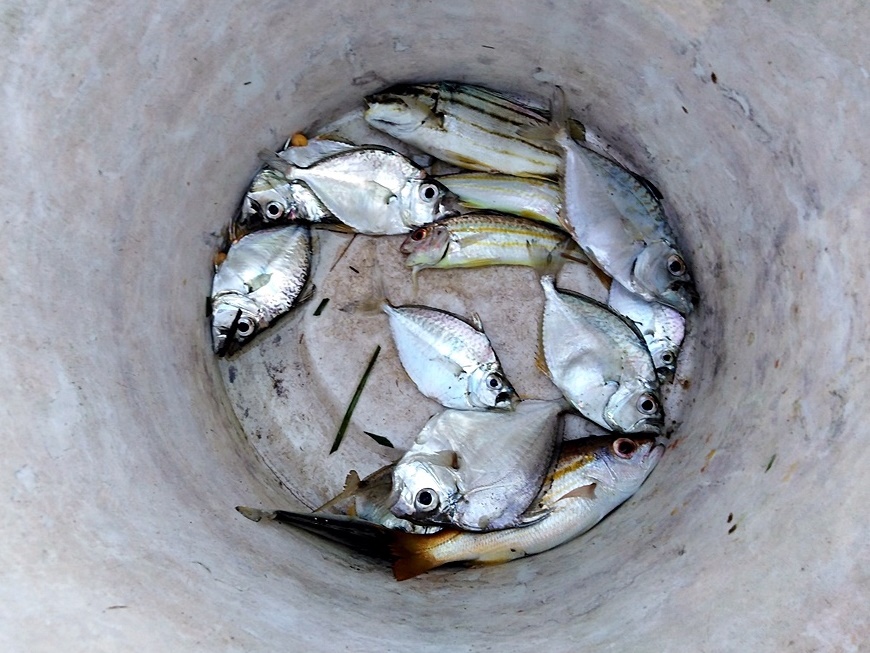
The international community, the UN and particularly the Food and Agriculture Organization or FAO recognizes the fisherfolk or specifically the small-scale fishermen, as marginalized and vulnerable. In the Philippines, it is commonly the municipal fishermen, as per classification of the Fisheries Code. As being Pamalakaya, or the National Federation of Small Fisherfolk Organizations in the Philippines, we refer our sector as “small fisherfolk,” as inclusion of the fisherfolk women, fish workers and other poor sectors in the ancillary industries. We also specify the term “small” so as to correspond to the exact marginalized sub-sector within the broader fisherfolk, which actually includes fisherfolk owning small commercial fishing boats.
The FAO recognizes that poverty among small-scale fishing communities is of multidimensional nature, not limited to the manifestation of low incomes, but also due to factors that impede full enjoyment of human rights, including civil, political, economic, social and cultural rights. In the Philippine context, the principle of “fishing rights” as mentioned in the Fisheries Code, is referred to as how to limit it, but not to promote it. Even the local ordinances based on this law, is all about how to curb down fishing opportunities of the small fisherfolk sector, than how to promote and protect it.
Briefly, the our experience, marginalization and vulnerability, manifesting poverty and hunger, are generated by the government policies and programs themselves. This political and economic context, superimposed by the inappropriate and incompetent response to the pandemic, is synonymous to worsened poverty, hunger and misery to the sector. We also clarify that it is not the pandemic itself that is wreaking havoc to the welfare of our and other poor sectors, but the government policies which is at this present proven catastrophic and detrimental to the Filipino people’s interests.
As brief data on vulnerability:
- there are around 1 million registered small fisherfolk of the total 1.6 million fisherfolk nationwide (BFAR);
- 1 million are employed in the fisheries and aquaculture sector (PSA);
- poverty incidence among fishermen were at 39% to 34% from 2012 to 2015, based on a poverty threshold of P5,513 and P6,329 (USD 0.87 and USD 0.93 per capita per day) per month for a family of five, respectively, this is among highest incidence with farmers and children;
- crudely if applied to the total number of employed in the sector, 442,000 families or 2.2 million fisherfolk population.
At present, the poverty threshold at P10,841 per month, or around P350 per day (USD 1.38 per capita per day), could still be daily reached by a typical small fishermen who usually catches 5 kilos at P60 per kilo or a value of P300. We at Pamalakaya, firmly believes that poverty in the fisherfolk sector is worse, given that government set standards is unrealistic and absurd.
Aside from the vulnerability generated by man-made factors, the fisherfolk is also a usual victim of natural calamities such as seasonal typhoons, the climate change manifestation of drought, volcanic eruptions and others. Unfortunately, upon these occurrences, adequate support from the government appears to be a fantasy, thus, we at Pamalakaya has taken the task of initiating relief missions for affected communities.
Gov’t policies not responsive to vulnerability

As the pandemic enters the country, courtesy of a tourist from China, the Philippine fisherfolk movement was one with other people’s organizations to demand an appropriate medical response, in protest of the military actions carried out by the government, via lockdown and massive deployment of armed forces. We joined the call for a free mass testing, as a decisive measure to resist the pandemic.
Militarist lockdown
In mid-March when the Luzon-wide lockdown or the invented “enhanced community quarantine” (ECQ) was imposed, we have already anticipated the impact on fisherfolk communities, specifically in Manila Bay areas, and Mega-Manila, or provinces near Metro Manila. These fishing communities are the usual suppliers of fish stocks within the metropolis.
Immediate reports were:
- fish catch in Bacoor City, Cavite province, south of Metro Manila, were blocked to the nearest cluster of barangays or villages within the city, more so towards the cities of Las Piñas, Muntinlupa, Pasay and Parañaque;
- sales and income from catching fish became irregular and uncertain, that led them to directly consume their stocks;
- eventually, this discouraged small fishermen to sail as they could not recover from the costs, particularly fuel;
- to continue, they resorted into getting loans;
- as impact, fisherfolk families suffered nil to low household incomes, throwing them to worsened state of hunger and hardships.
No Sail Zone
Natural from a militarist response, on March 14, the Manila Bay was declared “No Sail Zone” by the Philippine Coast Guard. We immediately protested this pronouncement as this spelled disaster to the livelihood of fisherfolk communities relying on Manila Bay, from the coasts of provinces of Cavite to Bulacan, Pampanga and Bataan.
The government was pushed back at the defensive with the Department of Agriculture and Bureau of Fisheries and Aquatic Resources or BFAR, scrambling with “clarification” that fisherfolk are exempted from such declaration. In case this pushed through, it would not only be the fisherfolk sector that could be affected but also poor sectors within Metro Manila.
Local Lockdowns
Based on various reports from local fishing communities:

- March under ECQ, it could be observed that small fisherfolk to subsistence fishing or directly consuming their catch, as per case in Cavite and various parts in the Bicol region, southern part of the Luzon major island.
- In April, a glut or oversupply took place for tamban (a type of herring fish) in the provinces Sorsogon, Camarines Sur and Misamis Oriental. This was a traditional season for the said fish, but amid the lockdown where tradelines were limited and hampered, prices fell down to as low as P20 per kilo, which could usually get as high as P120 per kilo.
- In May in Coron town, Palawan, seaweed products went to waste, as usual buyers, usually from the mainland or Batangas port were barred into getting them under the lockdown. Seaweed are prime export product of the country. Seaweed growers were forced into appealing for aid as they faced zero income from their products.
Negligible gov’t assistance
With similar fate with urban poor sectors within Metro Manila, small fisherfolk families could be considered as casualty sector with zero household income or purchasing power for the basic needs, especially food items. Many relied with getting loans from neighbors and aid from the civil society groups that carried out relief missions.
In the case of Bacoor City, from mid-March, under the ECQ until June 1, or under the “general community quarantine” (GCQ), a small fisherfolk family only received:
- three relief packs worth around P200 to P300, including two to three kilos of rice. For two and half months, the value of government assistance was only around P1,000 (USD 20 at P50 per USD);
- P6,500 as social amelioration program or SAP, to those who were given forms by the barangay council;
- cash for beneficiaries of the 4Ps or conditional cash transfer program.
If summed up (P1,000 worth of relief and P6,500 SAP), government assistance would be valued at P3,000 (USD 60) per month for two and a half months or P100 daily (USD 2).
This negligible level of gov’t assistance were also reported by peasant communities from various parts of Luzon, combined with the imposing of burdensome requirements to avail to the program.
Worse, the Department of Agriculture, announced in March 25, that there would be a separate social amelioration assistance for farmers and fisherfolk, but there was none. (Aside from the assistance from the Department of Social Welfare and Development, Department of Labor and Employment.)
But based on the 14 report documents of President Duterte from April 6 to June 22, for the so-called response to the pandemic, social amelioration, particularly for the fisherfolk, which is recognized as marginalized, vulnerable and among the poorest, was inexistent.
The very provisions that involved the fisheries sector was the Expanded Survival and Recovery Assistance (SURE Aid) Program, a loan program, and the rolling stores for agricultural products. All detached to the impoverished and hungry state of small fisherfolk in the country.
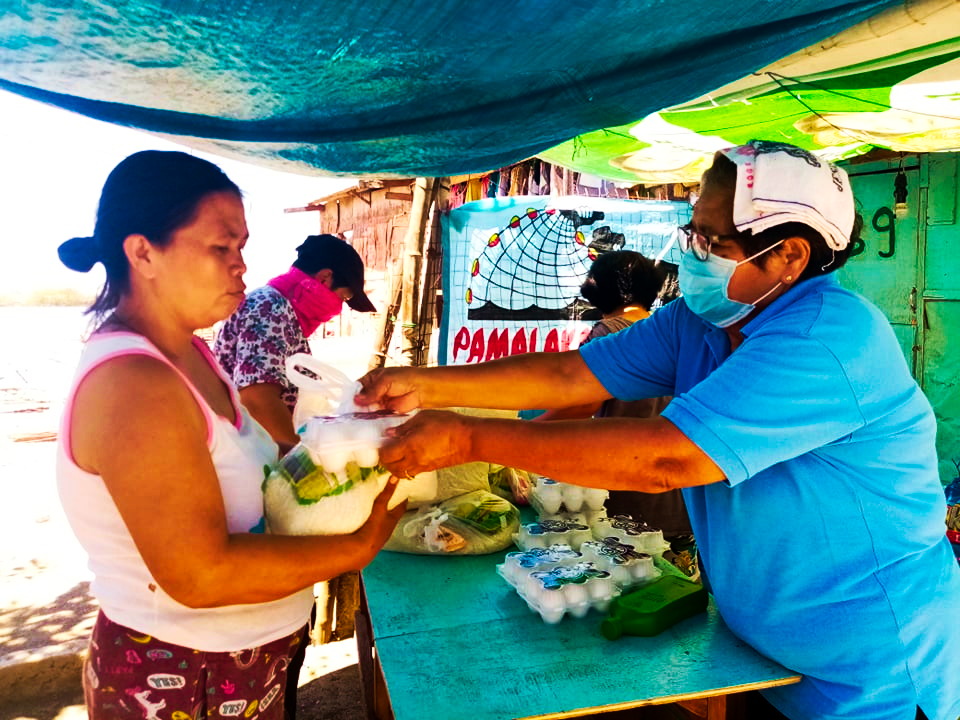
Continuing anti-fisherfolk policies and programs
Liberalization of fisheries
The vulnerability and and unpredictability of liberalization of fisheries in the Philippines was exposed by the pandemic. As characteristic of a liberalized fisheries, the small fisherfolk enjoys no siginficant state support, while export-orientation is promoted. Then as the pandemic raised uncertainties in the global trade and ultimately triggered lockdowns of major economies, this reflected the major blow in fisheries production.
For the first quarter, Philippine fisheries production declined by 5.2% equivalent to P3 billion (USD 61.3 million). The biggest loser was tiger prawn production which was down by P1.3 B (USD 26M). It is an export product, part of the USD 558-million shrimp and prawn export (2013), with destinations the US and EU, mostly France. Though, this export sector is dominated mostly by big traders and landlords, this certainly affected the sources of livelihood of fish workers and small fisherfolk in the country. Among export products with decline in production were mudcrab, P532 M (USD 10.6M), tuna , P97 M (USD 1.9M) and seaweed P85 M (USD 1.7M). Philippine fisheries is clearly a casualty of the pandemic’s exposé of the fragility and instability of globalization.

Rising Consumer Prices
As traditional symptom of liberalization, exacerbated by thoughtless lockdowns, the government triggered glut in the areas of production and scarcity in the areas of circulation. These has both victimized the producers and consumers.
- Last week of March, prices of fish products immediately increased, galunggong or roundscad from P190 to P200 per kilo (USD 0.20 increase), tilapia from P125 to P132 per kilo (USD 0.14) , and bangus or milkfish from P169 to P177 per kilo (USD 0.16).
- Last week of April, prices of galunggong or roundscad, spiked to more than P200 to as high as P240 per kilo from its usual pre-pandemic level of P120 to P160 (around USD 1.6 increase) per kilo.
The identified cause of these were that transportation of these products were directly blocked by government forces during the early phase of the lockdown, thus, pushing the Department of Agriculture to scramble in issuing food passes. Even so, these were hampered by heavy traffic caused by checkpoints, causing significant delay in their arrival to their destination. Some transporters even stopped operations due to rising cost, adding to the worsening of the problem. This was the same with other agricultural products such as rice, vegetables and meat. In addition, the food pass measure is discriminatory as it only covered traders who have adequate capital to cover additional costs and excluded small traders or vendors who are even blocked by local lockdown measures.
Reclamation of bay areas and other profit-oriented activities
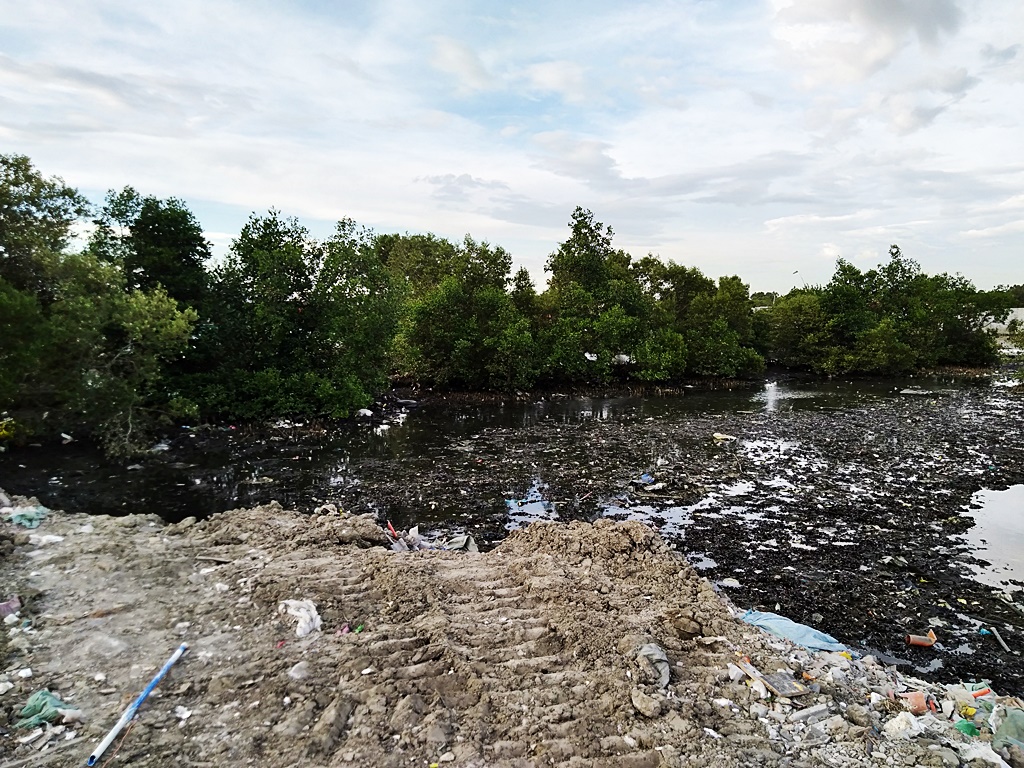
- Amid warning by the UN World Food Program Executive Director David Beasley of a hunger pandemic, or multiple famines of biblical proportions within a short few months last April, the Philippine government continues to promote destruction of marine environment in the name of profit promised by reclamation projects in Manila Bay.
- In June 2020, an environmental compliance certificate or ECC dated March 5 was bared for the Bacoor Reclamation Project in Cavite province, just south of Metro Manila. This project threatens the sources of livelihood of small fisherfolk families, as well as the breeding ground of marine life in Manila Bay. This is aside that the Supreme Court ordered rehabilitation of the fishery resources, not destruction, and obviously as being under the pandemic, food is supposed to be the primary concern of the people.
- Also in June, fisherfolk residents in Bulacan province, north of Metro Manila were harassed and threatened with violent demolition by government armed forces amid “quarantine” or “stay-at-home” orders by national and local government units. They are opposing the destructive 2,500-hectare Aerotropolis project being pushed by the comprador or national oligarch Ramon Ang, president of the San Miguel Corporation.
- Another incident last June 18, that affected the livelihood of small fisherfolk, was the grounding of M/V Zhong Hai 69 Alfa, a Chinese dredging vessel, at the bay of Botolan town, Zambales, facing the Panatag Shoal at the West Philippine Sea. Local fisherfolk decried of the oil spill preventing them from fishing at the area.
- Last July 3, 48,000 liters of oil spilled over the bay of Iloilo City, after a power barge owned by AC Energy, a firm of the oligarch Ayala. This has not only barred small fisherfolk from their sources of livelihood, but has also threatened their communities, thus, their evacuation at present.
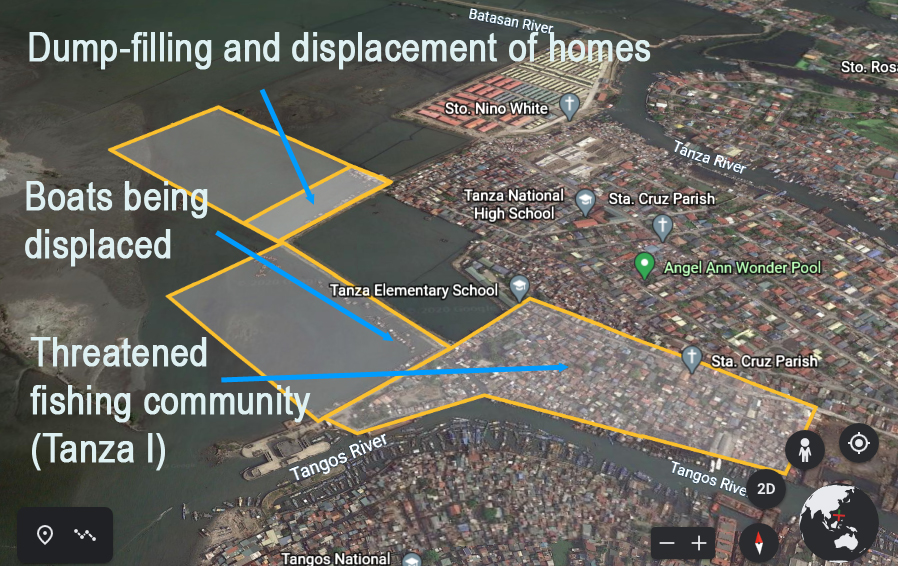
Ramming of F/V Liberty 5 with 14 fish worker victims
On the late evening of June 27, F/V Liberty 5 carrying 14 fish workers was rammed by a Hong Kong-flagged, Greek-operated, Chinese-crewed cargo vessel M/V Vienna Wood N, off the coast of Mindoro Island, south of Metro Manila. The victims remained missing at present.
Pamalakaya believes that the Chinese crew have grave accountability and raises its total disregard of local fishing vessels in the country, akin to the attitude of the Chinese vessel that rammed the F/B Gem-ver 1 in June last year, at Recto Bank, near Palawan province. We are presently calling for justice for the victims, immediate support to their families, and the urgent crafting of rules for the protection of Filipino fishermen against ramming by foreign vessels sailing in the territorial waters and exclusive economic zone.
Continued Chinese occupation of the West Philippine Sea
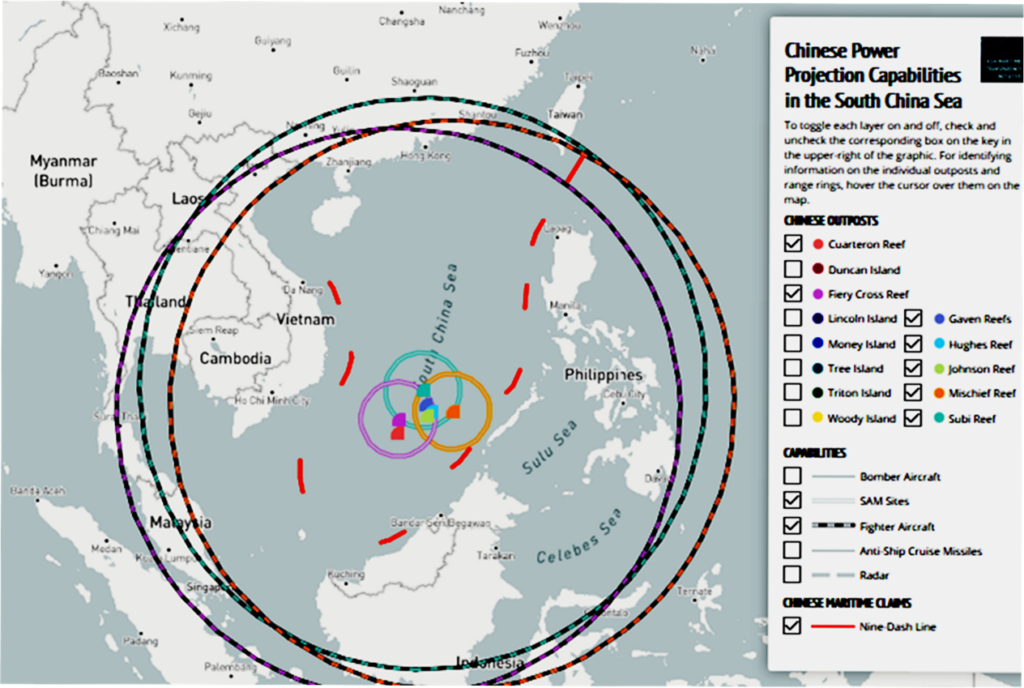
Even after 4 years of the historical decision of the Permanent Court of Arbitration that trashed the Chinese preposterous claim of “Nine-dash line” in the South China Sea, Chinese occupation continues. Due to the Duterte regime’s appeasement or surrender policy to China, the imperialist superpower was able to consolidate its hold of the region by reclamation projects which are now capable of military aggression. It has destroyed seven reef sites:
- Cuarteron Reef, Fiery Cross Reef, Gaven Reefs, Hughes Reef, Johnson Reef, Mischief Reef, Subi Reef,
- for its reclamation projects which are now military installations, capable of radar, deploying bomber and fighter aircrafts, surface-to-air and anti-ship cruise missiles.
Pamalakaya staunchly asserts that Chinese presence in the West Philippine Sea is Chinese imperialist aggression and plunder. Marine experts have already assessed that the country is losing P33 billion a year because of Chinese reclamation projects. This is aside from the actual plunder being carried out by China’s fishing militia, such as what rammed the F/B Gem-ver 1 in Recto Bank. We also believe that Chinese vessels actually enter the territorial waters, such as the case of 4 instances from February to July 2019. They sailed through Sibutu Strait which is within the territorial waters of Sibutu, a town of Tawi-tawi province, down south.
We are also blaming Chinese plunder on the continuing decline of production from commercial or high-seas fishing. This classification includes the 14-tonner F/B Gem-ver 1 from Occidental Mindoro rammed by a Chinese vessel.
- From the previously more than 1 million metric ton production in 2016, it fell to around 930,000 metric tons. Galunggong production, the species reported that Chinese exports to the Philippines, declined from 156,000 MT to 141,000 MT, to as low as 120,000 MT in 2018.
- Even production recorded by Metro Manila involving commercial fishing vessels which are among the best in the country, declined with 32% in all species, and in galunggong with a dramatic fall of 46% from 2016 to 2017.
- Among provinces whose commercial fishing vessels operate in the West Philippine Sea with decline are Batangas, Cavite, Oriental Mindoro and Occidental Mindoro with 74% from 2016 to 2019.
We are also stressing that the continued Chinese control of the Panatag Shoal, off the coast of Zambales province (near Subic Bay) is a continuing threat to the safety and welfare of Filipino fishermen as it serves as a sanctuary or refuge during unfavorable tidal and weather conditions.
- Recent developments in West Philippine Sea
- On April 2, a Chinese ship hit a Vietnamese fishing boat with 8 crew members near the Paracel Islands. The Chinese imperialists also arrested 2 other Vietnamese ships that came to rescue the fishermen. Pamalakaya condemned this imperialist act against Vietnamese fishermen.
- On April 18, China created its newest administrative districts, the Xisha District and Nansha District, under the Shansha City, located in Woody Island, the most southern town of the Hainan province. The Xisha District encroaches the Panatag Shoal, while the Nansha District covers Chinese occupied areas in the Spratly Islands. Pamalakaya expressed opposition against this imperialist declaration and pressed the Duterte government to act.
- In May, China declared a fishing ban in South China Sea, north of 12 degree north, or co-latitude of Coron island of Palawan. Pamalakaya expressed opposition against this clear violation of Philippine sovereignty and pressed the government to enforce local laws against Chinese vessels occupying the West Philippine Sea.
- From mid-April to early May, the US deployed the:
- aircraft carriers USS America (LHA-6), USS Bunker Hill (CG-52) and
- missile destroyer USS Barry (DDG-52).
- The USS America is equipped with F-35B Lightning II jet fighters, MV-22Bs Osprey and CH-53 King Stallion helicopters.
- The last two are claimed capable to launch naval assault against targets. In April, vessels of the two superpowers were reported to came as 100 meters close to each other. The US vessels are part of the Theodore Roosevelt Carrier Strike Group stationed in Guam.
Response of the Fisherfolk Movement
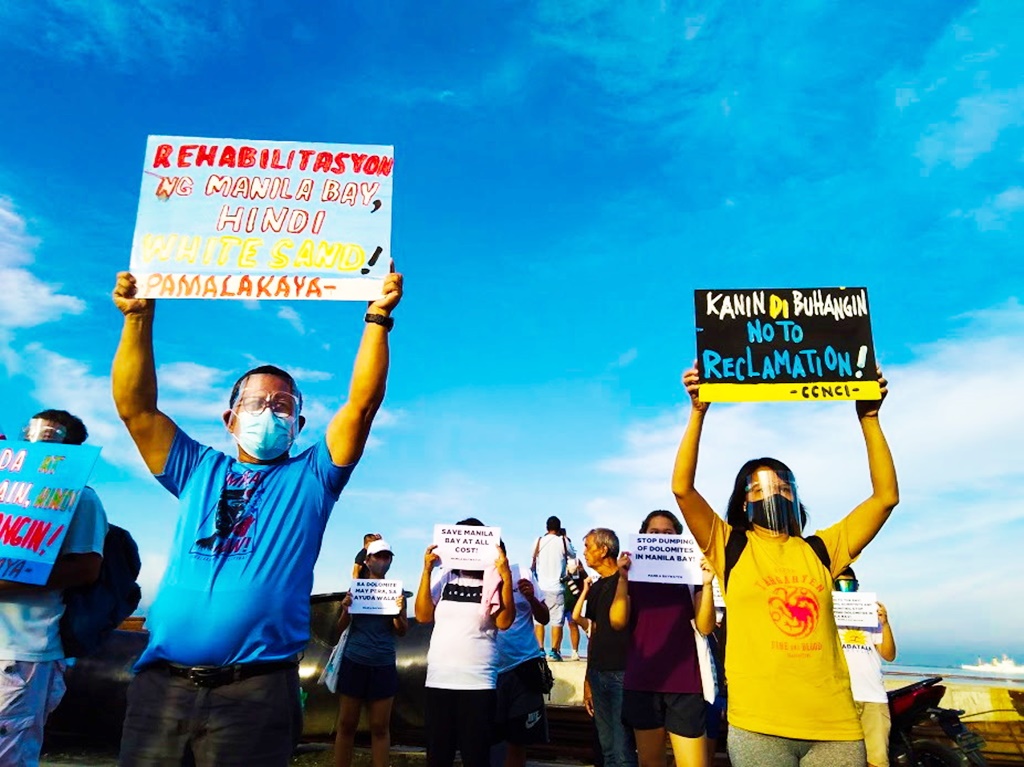
Mass mobilization
The primary form of struggle that Pamalakaya leads is mass mobilization or the concrete actions of affected fishefolk communities. Last year prior the pandemic, rallies by small fisherfolk from coastal communities of Manila Bay were customary in front of the DENR Central Office, Mendiola bridge in Manila, at the San Miguel Corp. head office in Ortigas Center and in front the Bacoor City Hall. Under the pandemic, as diligent adherence to protocols for public health, mass actions were held at communities by households and further broadcasted on social media.
Legislative Struggle
Pamalakaya leads to the legislative struggle for small fisherfolk issues, particularly on the drafting of measures as part of contribution to legislative work of the Anakpawis Party-list and Makabayan Coalition. These are mainly against reclamation projects in Manila Bay and Chinese imperialist aggression in the West Philippine Sea, against Displacement, Support to Fisherfolk production:

- House Bill No. 257 – Declare Manila Bay as “Reclamation-Free” Zone, July 1, 2019;
- House Resolution No. 489 – On the Undemocratic Process of the Approval of the 2,500-hectare San Miguel Corp. Aerotropolis project in Brgy. Taliptip, Bulakan, Bulacan, affecting small fisherfolk families, as being a reclamation project in Manila Bay, and destruction of its natural environment, November 11, 2019;
- House Resolution No. 1169 – On the June 27, 2020 – Collision between the Hong Kong-flagged and Chinese crewed M/V Vienna Wood N and F/V Liberty 5, and subsequent abandonment of 14 fish worker victims, August 27, 2020;
- House Resolution No. 1170 – On the Threat of Displacement of the Fisherfolk Community in Brgy. Tanza 1 and other barangays in Navotas City, amid dump-filling or reclamation activities, and pending 650-hectare Navotas Coastal Bay Reclamation project; August 27, 2020;
- House Resolution No. 1171 – Urging the National Government to regain control and authority over the Panatag Shoal and Kalayaan Island Group amid the April 18, 2020 – declaration of the Chinese government of new Administrative Districts, August 27, 2020;
- House Bill No. 7524 – Special Protection to Coastal Fishing Communities for Sustainable Small-Scale Fisheries in the Country Act, August 27, 2020;
- House Bill No. 7525 – P15,000 – Financial Support to the 1 Million Frontliner Fisherfolk Act, August 27, 2020;
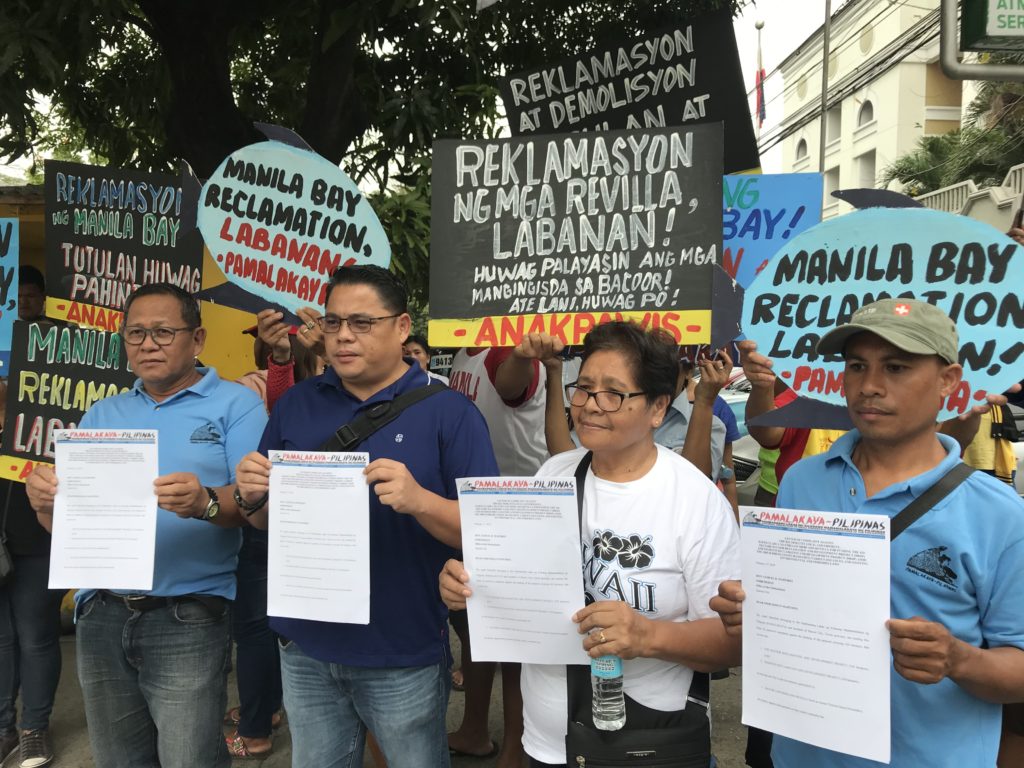
Legal
Aside from the many dialogues with local government units (LGUs) prior the pandemic, Pamalaka led the filing of the complaint against Bacoor City Mayor Lani Mercado-Revilla for her pushing of the 420-hectare Bacoor Reclamation Project, that violates the the 2008-Supreme Court Mandamus to ‘clean-up, restore, and rehabilitate’ Manila Bay; the Administrative Order No. 16 expediting the rehabilitation and restoration of Manila Bay and the creation of its task force; and the Manila Bay rehabilitation program of the DENR.
Alliance and Networking
Pamalakaya has been cooperating with other groups, particularly on opposing reclamation projects in Manila Bay. We are one of the allied groups of Manila Bay Watch or the people’s movement for genuine rehabilitation of Manila Bay and against reclamation project. We are also coordinating with youth environment groups and even celebrity artists, for collaboration for coastal clean-up and relief effort activities.
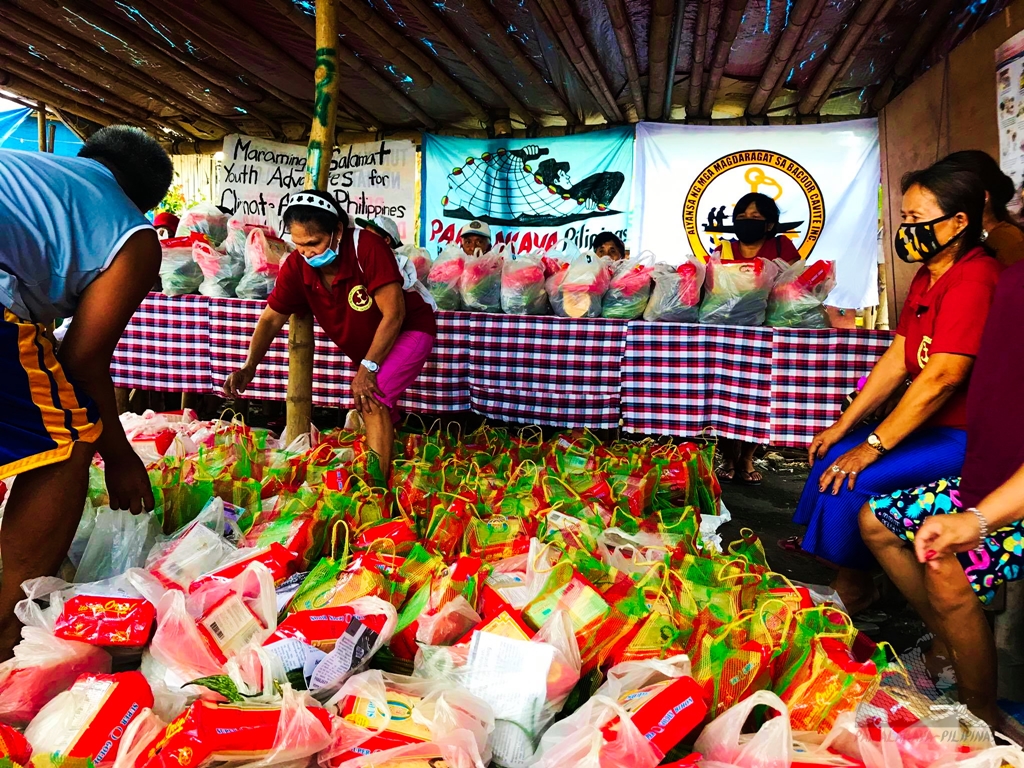
Relief efforts
Pamalakaya has carried out numerous relief mission activities, in cooperation with other groups, at the fisherfolk communities of Bacoor City and adjacent towns, in Manila and Navotas City and those affected by the Taal volcano eruption.
Massive and sustained Public Information Campaign and Media Work
Pamalakaya always take the task of broadcasting to the mass media to build public opinion and support, the fundamental issues of small fisherfolk communities, for the advancement of fishing rights, defense against displacement and destruction of the marine environment, especially reclamation projects.
Recommendations
For the national government to seriously implement the Manila Bay rehabilitation
The 2008 Supreme Court mandamus is clear that it ordered various agencies with the mission parameters such as:
- Reduce the coliform level to SB level or suitable for recreation;
- Improve and restore the marine life of Manila Bay;
- For the BFAR to coordinate with LGUs for fisheries and aquatic resources development.
XXX WHEREFORE, judgment is hereby rendered ordering the abovenamed defendant-government agencies to clean up, rehabilitate, and preserve Manila Bay, and restore and maintain its waters to SB level (Class B sea waters per Water Classification Tables under DENR Administrative Order No. 34 [1990]) to make them fit for swimming, skin-diving, and other forms of contact recreation. XXX
From the February 2011 Supreme Court mandamus resolution (based on the December 2008 decision) https://lawphil.net/judjuris/juri2011/feb2011/gr_171947_2011.html
(5) Pursuant to Sec. 65 of RA 8550, the DA, through the BFAR, is ordered to improve and restore the marine life of the Manila Bay. It is also directed to assist the LGUs in Metro Manila, Rizal, Cavite, Laguna, Bulacan, Pampanga, and Bataan in developing, using recognized methods, the fisheries and aquatic resources in the Manila Bay.
Ibid.
For the national government to scrap reclamation projects in Manila Bay and declare it as “reclamation-free” zone
It is elementary that reclamation projects will destroy the marine environment of Manila Bay, undermine fishery resources development and displace fisherfolk communities. The government should adhere to the Supreme Court mandamus or face contempt for its conscious advancing of programs and projects contradicting its wisdom.
For the national government to provide the P15,000 financial support to small fisherfolk
The small fisherfolk sector is recognized globally as one of the most “vulnerable and marginalized,” but in the government’s supposed pandemic response, the sector was again marginalized and was not recognized as a sector in dire need of support. This continued neglect will impact the national fisheries production, consequently, affecting the national economy, the population and national food security.
